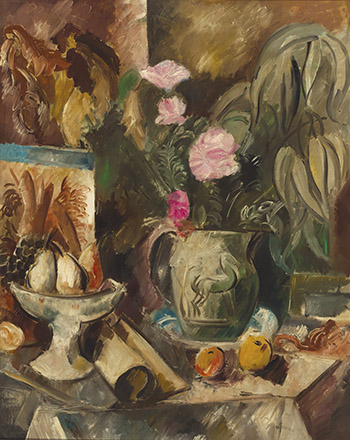PROVENANCE:
Dimensions Art Center, Taipei
Private collection, Asia
This painting is sold with a certificate of authenticity issued by Robert Martin (a member of syndicat français des experts professionnels en oeuvres d'art).
Catalogue Note:
VASE DE FLEURS ET COUPE DE FRUITS
CHARLES DUFRESNE
Charles Dufresne was a French painter, sculptor and designer of the 19th century. Born in a fishing family, he left school early and became an apprentice in sculpture due to poverty. He then entered an academy of arts to learn the production of art medals from master sculptors. Out of interest, he plunged into the art of painting and learned the skills by himself. Most of his early works center on café music perfor mances and circuses. Awarded the Prix de l'Afrique du Nord (North Africa Award) in 1910, he grasped this opportunity and moved to Algeria, a colony of France, living there for two years. The experience of living overseas and the unique culture of North Africa opened another window in art for Dufresne. Infatuated with the exotic and lyrical landscape, he began creating oil paintings in 1911. His oils of this time wer e obviously influenced by the style of Cubism. The renowned 19th-century Romantic artist Eugène Delacroix, however, also had great impact on Dufresne’s use of color and choice of themes. Delacroix had also made a huge breakthrough in painting after his visit to Africa in 1832, creating a great number of exotic paintings. He consciously employed contrasting colors and regained the majestic strokes popular in the 18th century. Such a style is also evident in the works by Dufresne. After his time in North Africa, Dufresne intentionally used colorful and contrasting tones to strengthen the expression of his works, reaching a kind of harmony and unity between the composition and the color. At the same time, he also created a large number of fine pieces involving the landscape in North Africa. He often chose strong colors, such as dark brown and ocher, and simplified forms to construct his paintings. Cezanne’s influence is evident in his figure paintings, and especially in the solid shapes and generalized images of his still lifes. It was because of such diligence and hard work that Dufresne was able to use the strengths of various art masters and develop his own diverse but u nique style, leaving his own footprint in the history of Fr ench modern art. His 1919 work “Spahi Attacked by a Lion” is in the collection of the Tate Museum.
Still life is an everlasting theme in painting because artists can freely express their skills in the depiction of those objects. As with many of the still life paintings by Dufresne, the artist also employs vivid coloration and makes use of the strong contrast between cool and warm colors in “Vase de fleurs et coupe de fruits.” The artist has carefully arranged the position of the still life, forming a slight imbalance between the fruits in warm colors in the foreground and the slightly tilted basket in cool colors. In the middle ground, however, the cool tone of the vase and the colors of the leaves step up to balance the whole painting. To maintain the characteristics of each object, the artist has adjusted the color of the background with fine but orderly strokes. The shapes of the vase and the fruits are simplified and deformed, which builds a close spatial relation between the objects. Such careful design, which resembles accidental disorder, reminds one of the heavy forms in the works of Cézanne.
